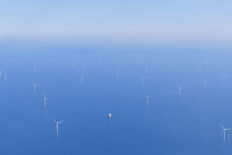- Ørsted reduced its scope 1 and 2 emissions by over 98% since 2006.
- The company achieved a 99% renewable energy share by 2025.
- Ørsted aims for a 2040 net-zero target across its value chain.
- Efforts include decarbonizing steel, copper, and maritime fuels.

Decarbonisation Achievement
Ørsted has successfully transformed from a fossil-fuel-intensive utility to a leader in renewable energy, achieving a 99% renewable energy share and reducing scope 1 and 2 emissions by over 98% since 2006.
Path to Net-Zero
The company plans to continue reducing emissions across its value chain, aiming for a science-based net-zero target by 2040. This includes efforts to decarbonize materials like steel, copper, and maritime fuels.
Strategic Actions
Ørsted's transformation involved deploying offshore wind power, closing coal-fired plants, converting remaining plants to sustainable biomass, divesting oil and gas activities, electrifying its vehicle fleet, and using renewable electricity certificates.
Future Collaborations
Moving forward, Ørsted will work with partners to systematically reduce emissions across scopes 1-3, aligning with its 2040 net-zero roadmap.

